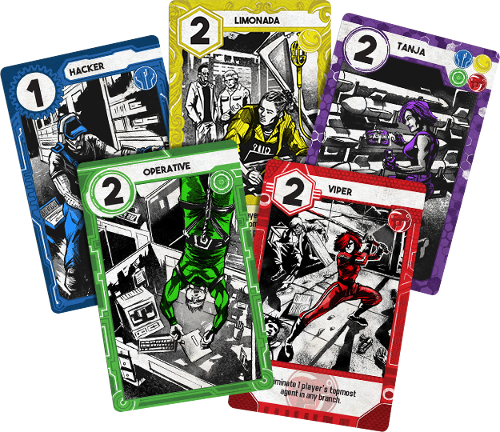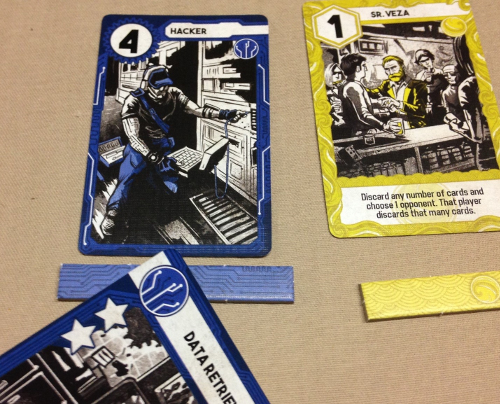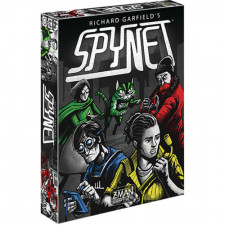SpyNet Review
on Oct 25, 2017
Critical Hits: Compact, simple drafting design.
Critical Misses: Somewhat bland, repetitive gameplay.
Richard Garfield is a legend. This dude created Magic the Gathering, RoboRally, Netrunner, King of Tokyo, and 400 other notable designs. Yet that meant very little when I read the brief rules booklet for SpyNet and thought, "and that's it?"
And this is where SpyNet began to impart its wisdom. Not only did I learn about blackmailing covert assets working for the other side, but I also learned a great deal about the benefit of the doubt and when it should be given. Touché Garfield.
SpyNet is a solid package. It's a little deck of cards with some wicked Sin City inspired illustrations. It contains a frankly surprising degree of strategy for such a small footprint and modest 20 minute playtime. At its core this is a draft management game, which is novel yet not altogether clear since I just made up the term.
Nevertheless, the card selection at the center of the design is the Garfield coined "Winston draft" (aha, I'm not the only one making stuff up). Three piles lay adjacent to the draw deck. They each begin with a single card, face-down and teasing you with possibility. On your turn you can choose to either rummage through these cards with a recruit action, or to deploy spies from your hand and play missions for points.
When drawing cards you must look at the piles in order, making an astute decision to keep the group or move on to the next with no going back. You work your way through the three sets before possibly settling on the top card from the deck. Afterwards, every pile you looked at receives an additional card from the deck, propping up its value. This is vaguely similar to the coin mechanism in Puerto Rico where incentive is added to roles that are not selected. It's tried and true and we've never seen it utilized quite like this. Never change Richard.
The Winston draft injects a measured degree of "push your luck". That conundrum of keeping two slightly useful cards versus hoping for a better pull in the next pile is compelling. It offers a great deal of strategy and player directed control over randomly seeded elements. When you lose at SpyNet it often feels like you didn't manage the card piles as well as your opponents, which is a satisfying and meaningful conclusion to draw.

They’re no agent Cooper, but they’ll have to do.
The idea is to acquire agents in one of four different colors, preferably with high values. You deploy them to a matching colored band in front of you in an attempt to control it. Each area represents a different field being targeted such as tech, infiltration, and enforcement.
After placing a spy you may play mission cards from your hand to areas where you have the highest value operative. This is simple and sly on a subtle level. Digging through cards for high values sounds about as sophisticated as a filet o'fish, but SpyNet challenges that assertion. The way acquisition interfaces with deployment buoyed by that draft simply works, about as well as you'd expect a Richard Garfield joint to.
While this core structure is enticing and strategic, it's simultaneously a bit bland and repetitive. This is alleviated somewhat by lower value spies offering special effects such as "flipping" an enemy operative to your side - which is roughly equivalent to flipping your opponent the bird. You can also off agents and remove them from play. These both add much needed volatility to keep the competition dynamic. Surprisingly, a great deal of restraint is shown and the game manages to pull back from being outright chaotic or wild.
Placing those missions into controlled bands are what gains you points for the end game. This is muddied a bit when playing with four players as SpyNet takes the infrequently traveled route of team play. You control areas independently from your ally, but you total your scores at end game. It would feel an inconsequential and almost pointless structure if not for the ability to pass a card to your teammate at the end of your turn. Since communication is restricted (spies don't talk silly), this adds a solid touch of setting emulating a dead-drop and information passing. It's slick and simple, much like the overall design wrapping it.

Hackers gonna hack.
SpyNet does much right and little wrong. Its greatest weakness is that it resides as filler, one that leans more strongly on the strategic theater than the social one. The personality suffers from being somewhat stale and unexciting when compared to the more raucous stalwarts competing for this slot - titles such as Skull and Cockroach Poker. The content here is going in the opposite direction, appealing to those who prefer more thoughtful play in a modest time slot.
This design also isn't exceptional at three players, although it succeeds quite well at two or four. The decision to introduce the team mode as the standard was clever as it works to separate the game from its competition. SpyNet may not ultimately stay in circulation as long as an average $20 bill (7.9 years for the curious), but it certainly makes a case for its value in comparison.

 Customer Support
Customer Support  Subscribe
Subscribe 




 Account
Account  Wishlist
Wishlist 

